Science Instruments
The LADEE spacecraft hosts three instruments: NMS – the Neutral Mass Spectrometer, UVS – the Ultraviolet/Visible Spectrometer and LDEX – the Lunar Dust Experiment. In addition, the payload suite includes a single technical demonstration payload – LLCD, the Lunar Laser Communications Demonstration. The UVS and LDEX instruments are installed on top of the Radiator Assembly while the two heavier payloads, NMS and LLCD are mounted on opposite sides of the payload module to maintain a stable Center of Gravity which is important for vehicle control.
Instrument Locations
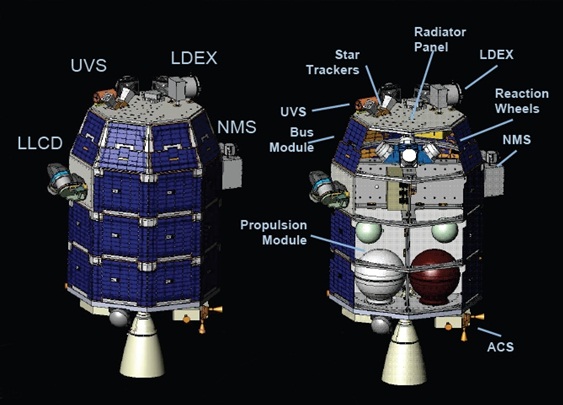
LADEE Science Animation
NMS – Neutral Mass Spectrometer
LADEE’s Neutral Mass Spectrometer will help determine the composition and temporal & spatial changes of the lunar exosphere by detecting and measuring a number of species including Helium, Argon and Radon. The NMS payload is based on the Neutral Gas and Ion Mass Spectrometer that was developed for NASA’s CONTUR mission. It also shares heritage with spectrometers flown on NASA’s Cassini Saturn orbiter and Curiosity Mars rover. The payload unit uses refurbished components built for CONTUR, but with a new ion/electron optical design, NMS has a higher sensitivity to improve measurements in the low-density lunar exosphere.
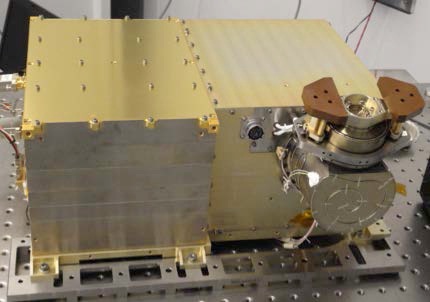
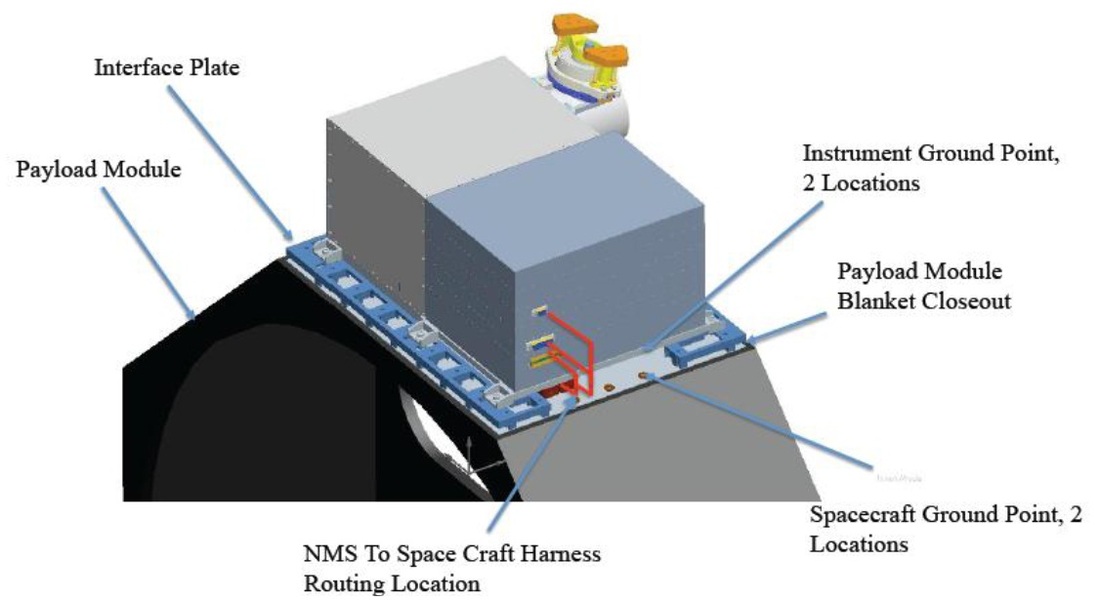
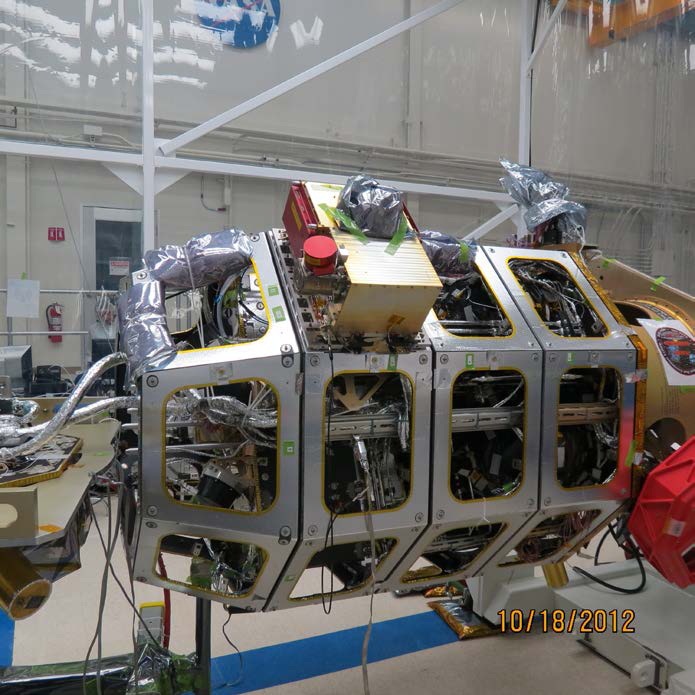
NMS was developed at NASA’s Goddard Spaceflight Center with a number of participating organizations including the University of Michigan, AMU Engineering, Nolan Engineering and Battel Engineering.
The heart of NMS is a Quadrupole Mass Spectrometer, QMS. A Quadrupole Mass Spectrometer consists of four parallel metal rods with opposing rods being connected electrically. A radio frequency voltage is applied between the two pairs of rods and a direct current voltage is then superimposed on the RF voltage. Ions entering the instrument travel down the quadrupole between the rods.
Depending on their mass-to-charge ratio, ions either enter unstable trajectories and collide with the rods or make it through to the detector. The m/z of ions reaching the detector is a function of the voltage setting which allows the operator to select an ion with a particular mass-to-charge ratio to measure its abundance or run the instrument through a range of voltages to scan for a number of species that might be present. NMS uses hyperbolic rods and has a mass range of 1-150 u (atomic mass unit).
To create ions, NMS is outfitted with an open and a closed ion source that ionizes atoms and molecules present in the exosphere. The closed source can be used for species that do not adsorb on surfaces within the ion source such as Helium, Argon and non-reactive neutrals as particles collide with the wall of the source multiple times prior to ionization. The open source is suitable for neutrals and ions that are surface reactive. It ionizes species and focuses them into the quadrupole without any wall collisions.
The two sources use electron ionization. Electrons are produced through thermionic emission. The electrons are accelerated in an electric field and focused into a beam by a trap electrode. The atoms and molecules enter the ion source perpendicular to the electron beam. As high-energy electrons pass by and collide with the particles, large fluctuations in the electric field around the neutral molecules are caused leading to ionization and fragmentation. A repeller electrode then attracts the produced cations towards the mass analyzer. NMS will also study ambient ions by turning off the electron beam and directing natural ions into the mass spectrometer through the open source.
Detector integration time on NMS is 30 milliseconds. The NMS can switch to either m/z value within its range (1-150 Da) in all three modes (open, closed, ion) within 30 milliseconds allowing much of the integration time to be spent on the mass channel of interest. In ‘adaptive mode,’ NMS scans bands of m/z ranges to search for unexpected species. In case the signal in any of the bands is above the threshold, increased scan time is automatically allocated to that band by the instrument control system.
The LADEE NMS payload consists of the spectrometer instrument unit and an instrument electronics box that is connected to the data system via a serial RS-422 high-speed bus. NMS weighs 11.3 Kilograms and is 43 by 25 by 37 centimeters in size. The instrument requires 34.4 Watts of average power and returns 3.5kbit/s of data in science mode.
NMS Components

NMS Observing Modes
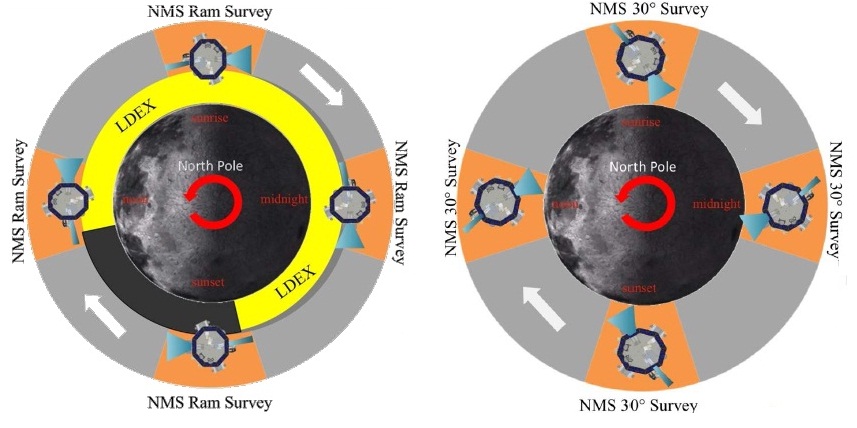
UVS – Ultraviolet/Visible Spectrometer
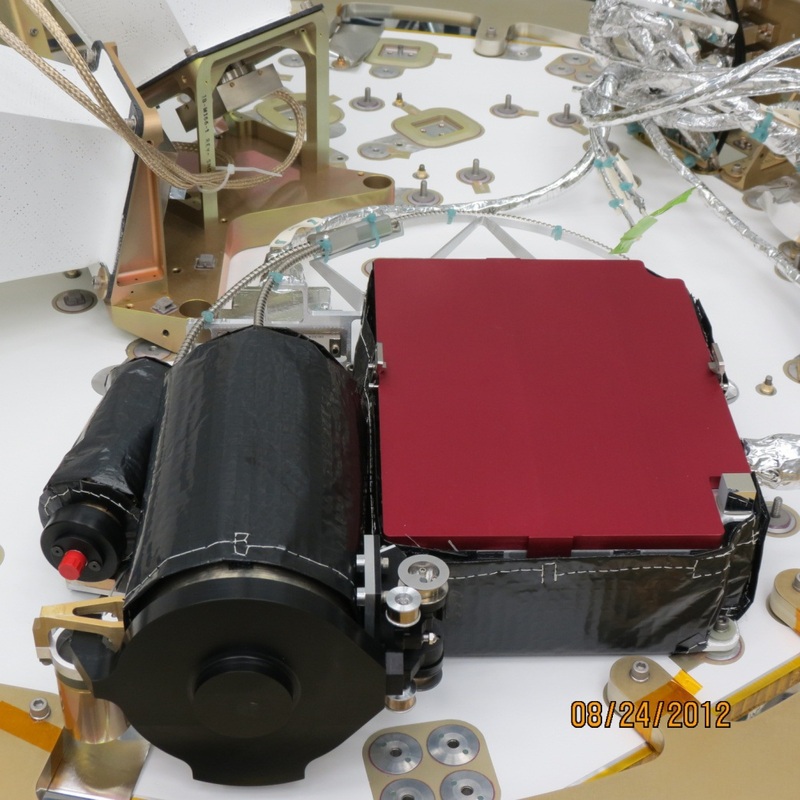
The Ultraviolet/Visible Spectrometer is the next generation, high-accuracy and high-reliability version of the UV-VIS Spectrometer used on the LCROSS spacecraft. UVS was developed at NASA’s Ames Research Center with participation of Aurora Design & Technology, and Visioneering LLC. The payload consists of a solar viewer, a limb telescope and the spectrometer unit. The limb telescope and the solar viewer are connected to the spectrometer by a bifurcated optical fiber. UVS observes the lunar exosphere monitoring the two known species sodium and potassium and also searching for other species such as silicon, aluminum, magnesium, calcium, titanium, iron and water.
The instrument can detect scattered light from dust from altitudes of a few Kilometers up to about 50 Kilometers using the limb telescope. Also, the instrument can perform dust occultation measurements to study dust very close to the surface at altitudes as low as 300 meters. UVS examines the exospheric emissions and a broader continuum of light scatter by dust down to 10nm in size.
The instrument has a spectral range of 230 to 810 nm – covering the near and medium ultraviolet and the visible spectrum and the initial portion of the near infrared spectrum. The instrument provides a spectral resolution of under 1 nm. The field of view is about one degree.
The UVS Limb Telescope is pointed just above the surface of the Moon, looking at its limb to detect emission by exosphere gases and backscattered radiation caused by dust. In a typical science orbit, limb observations will be centered on the morning and evening terminators as well as local noon. During nominal operations, the telescope is pointed no more than 20km above the surface. After each of these limb ‘stares,’ a ‘nod’ is performed during which the field of view of the telescope is nodded down below the limb so that the lunar surface occupies the entire field of view followed by a nod up to 50km. This procedure will provide data on altitude variations in gases and dust and provides important calibration data for zodiacal light and light scattered into the telescope from the lunar surface.
The solar viewer allows UVS to stare at the Sun to monitor it as it rises and sets across the lunar limb as part of occultation measurements. Solar occultation measurements achieve high signal-to-noise ratios at very short integration times. UVS will scan for extinctions due to dust down to very low altitudes.
UVS weighs 3.98 Kilograms and requires 14 Watts of power. It is connected to the central avionics unit via a RS-422 serial link.
UVS requires temperatures between –20 and +40°C and is equipped with several temperature sensors and heaters to keep the instrument at a stable temperature.
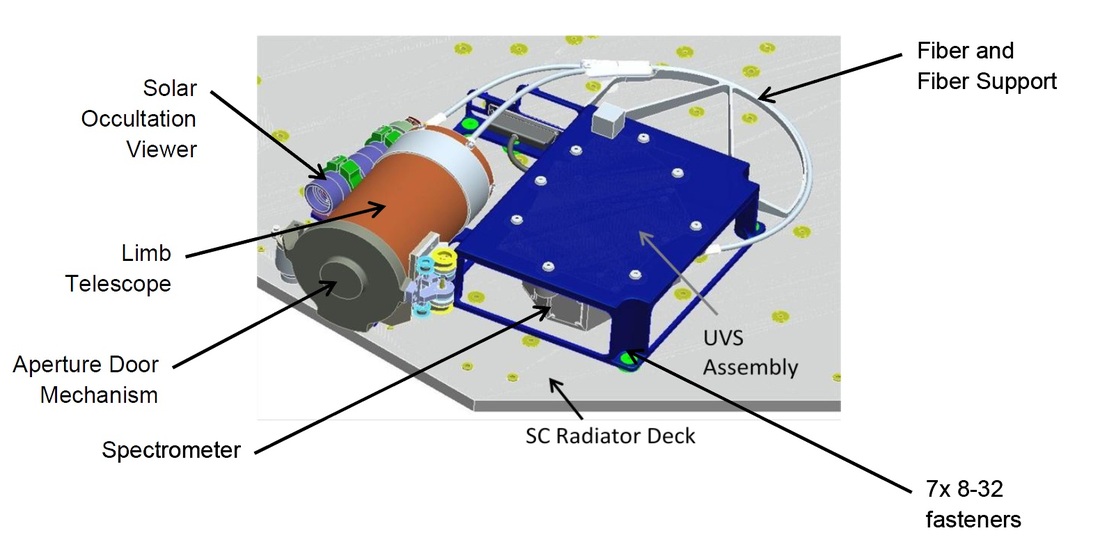
LDEX – Lunar Dust Experiment
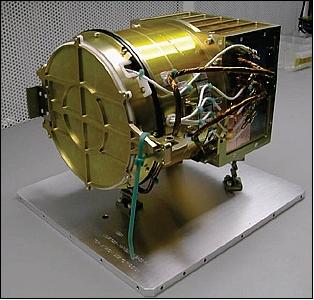
The LDEX instrument is designed to examine the local and temporal variability of dust distribution in the lunar exosphere taking into account dust grain size and density. LDEX is an impact ionization dust detector that obtains in-situ measurements at LADEE’s orbital altitude. The instrument can detect dust grain sizes of 100 nanometers to 5 micrometers.
LDEX has been developed at the Laboratory for Atmospheric and Space Physics and Colorado Center for Lunar Dust and Atmospheric Studies. LDEX uses heritage components that were used on previous instruments including the Cassini spacecraft.
The LDEX impact ionization dust detector has a sensor area of about 1 square centimeter. It is a compact, low risk instrument with no deployable components (with the exception of a deployable door) and no flight software. A dust particle impacts the hemispherical target of LDEX and generates a plasma cloud. A –200-Volt bias is applied on the ion focusing grid and generates a radial electric field that separates electrons and ions that are generated on impact. The electrons are collected on the target and are detected by a charge sensitive amplifier. The ions travel to the center of the sensor and are detected by a microchannel plate that is placed behind the focusing grid.
The MPC is divided in two sections, each collects about half of the signal. MCP outputs are connected to current-to-voltage amplifiers in order to measure the the current pulse of the impact. The two MCP signals are being used for coincident detection ensuring the identification of dust impacts as cosmic ray or solar particles only cause a signal on one of the MCPs. Such detections are rejected.
The mass and size of dust impacts are calculated using data from the MCP and CSA as well as laboratory calibrations.
LDEX Design
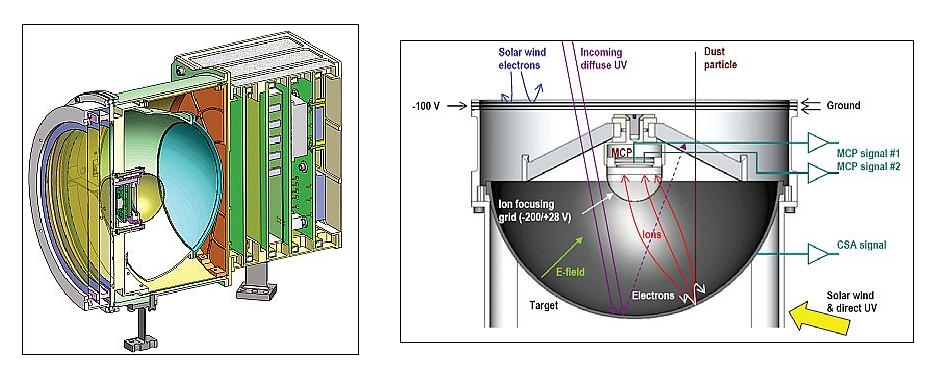
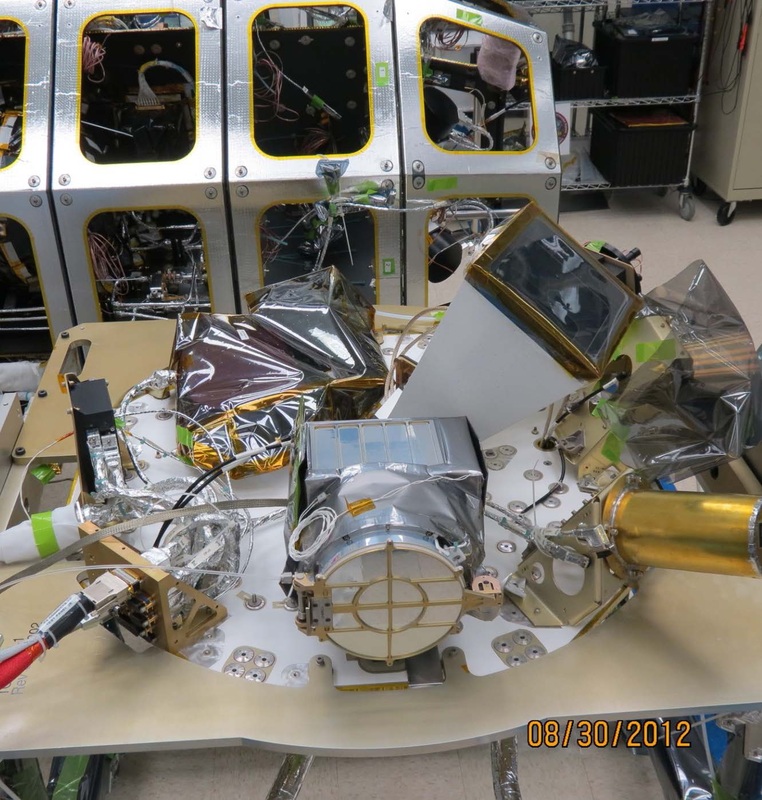
LDEX can measure impacts of individual grains with sizes of 0.3 microns. Smaller particles can be detected as a collective as LDEX uses a 0.1-second integration time to measure the cumulative charge of impacts of particles as small as 0.1 microns. Measurements of particle collectives include noise that requires noise background measurements every 10 seconds to correct the science data.
Every 10 seconds, the bias on the ion focusing grid is switched from –200 to +28 Volts for a duration of 1 second. The positive bias stops all dust impact generated ions which results in MCP only picking up background noise.
LDEX has a temporal resolution of less than 3 seconds to make at least 100 measurements in 6 minutes over a 20-degree region approaching the terminator.
LDEX has a mass of about 3.5 Kilograms. It is 15 by 15 by 20 centimeters in size and requires 6 Watts of power. It provides a data rate of 1kbit/s that is transferred to the avionics unit via the RS-422 bus.
LDEX has no operational temperature requirements, but is equipped with a single heater that ensures the instrument survives in extreme thermal environments.
LDEX was designed by the Laboratory for Atmospheric and Space Physics, University of Colorado and calibrated in Germany at the Heidelberg dust accelerator facility.
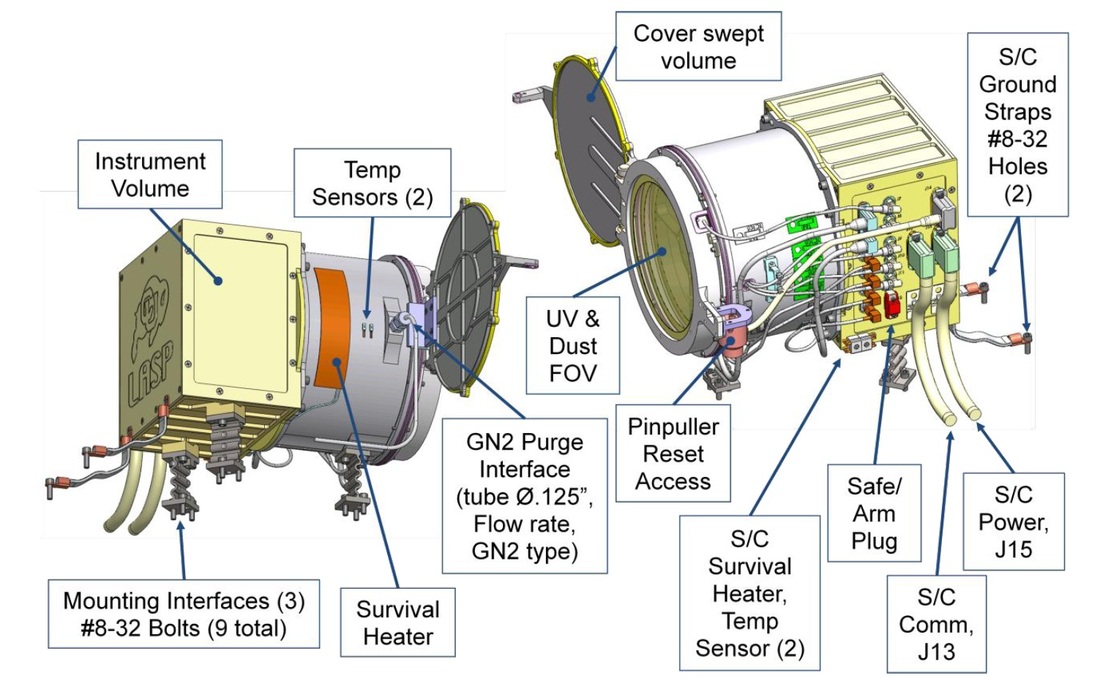
Lunar Laser Communications Demonstration
Part of LADEE’s payload is a technical demonstration that will be used to demonstrate high data rate optical communications between Earth and the Moon in preparation for use of Laser Communications for space and deep space applications. The LLCD System consists of three primary parts: The Lunar Lasercom Space Terminal mounted on LADEE and the Lasercom Ground Terminal with Lasercom Operations Center on Earth. Because the LLCD system is part of the payload, it is not considered part of LADEE’s communications system as all data that is required for mission success is up- and downlinked via LADEE’s S-Band system. LLCD will only demonstrate data transfers.
The project is being managed by the Massachusetts Institute of Technology MIT and Lincoln Laboratory LI in cooperation with NASA’s Goddard Spaceflight Center. The goal is to demonstrate duplex optical communications from a spacecraft in lunar orbit to an Earth-based receiver. LLCD achieves data rates of up to 620 Mbit/s for downlink and 20 Mbit/s for uplink. Additionally, the payload will demonstrate laser ranging with a 2-way time of flight error of less than 200 picoseconds providing sub-centimeter accuracy.
